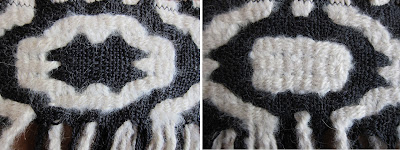I am very linear, which of course is a good attribute for a weaver. I like being involved in a big project, which gives me focus and a reason to get out of bed in the morning. Long ago, when I owned and ran a restaurant in Panajachel, Guatemala, I understood that I liked knowing everyone and being friendly, but also that the responsibilities of the restaurant kept me too busy to do anything that wasn't involved with running the restaurant, and it kept me out of trouble. I suppose this is another way of saying boundaries can be helpful.
The keeping out of trouble refers to my own mind and my inclination to activities such as computer games and reading. Reading is okay, but that other thing..... Anyway, I don't have any big projects on my calendar right now and it is a perfect time to explore. Which if you have read my recent blog posts you know I am doing: card weaving, taqueté, tapestry, reading, and yes, that other unmentionable activity. So this story begins with my trip to Conway, MA to purchase a small Mirrix loom from Elisabeth (Lisa) Hill.
 |
| Lisa Hill and some of her amazing fabrics |
 |
| Details of four scarves woven by Bhakti Ziek for Wild Hair Alpacas |
 |
| Laurie Autio, Ute Bargmann and Lisa Hill--all three are master weavers with certificates from The Hill Institute |
 |
| Laurie showing some of her lace work (left and right); Ute in the center with her tablet woven bands, many of which are brocaded |
 |
| Lisa Hill modelling alpaca scarves and a shawl woven by Bhakti Ziek |
 |
| Pilgrimage to Vävstuga Weaving School, next to the Bridge of Flowers in Shelburne Falls, MA and then to their offsite location where the drawloom class was in session |
 |
| First deflected double cloth woven by Bhakti Ziek, unwashed top left and washed, bottom right |
 |
| Small sample of Bhakti Ziek's deflected double cloth but beaten tighter than the scarf |
 |
| Gilmore inkle loom--old style with weaving by Bhakti Ziek |
It's not that I don't think the process is perfectly wonderful. In fact, I am totally inspired by what Daryl Lancaster does with her inkle loom. She uses the bands for her incredible handwoven garments--it makes sense for her to make the cloth and the bands. And she has written a book on using the inkle loom that I plan to order (and when I was in doubt an email to her got an immediate response with a diagram of the old Gilmore loom like I have). But I feel fractured by all this exploring and long to return to my TC1 and the taqueté and samitum study that I have neglected (and to continue with the tapestry lessons). There are so many avenues one can go down as a weaver, but my birthday is next week, and I better start pruning myself so I am not just rambling around as I near the end of my 60s.
 |
| Dimity studies, above face and back of a study by Lisa Hill; below a study by Ute Bargmann |






Don't prune too much. Your branches are a treasure. I love what you're doing.
ReplyDelete